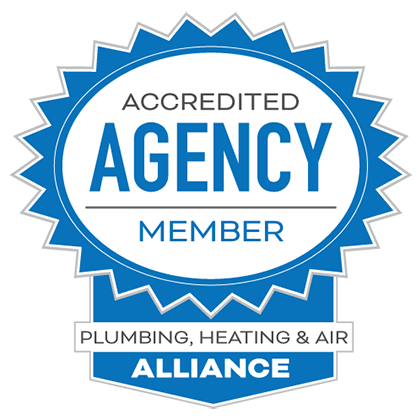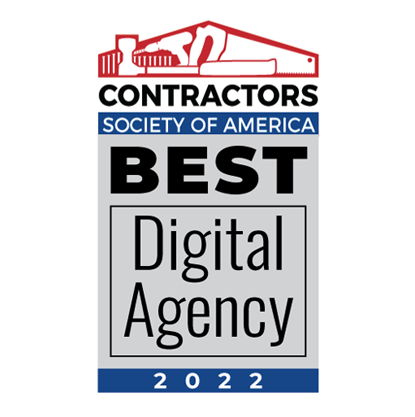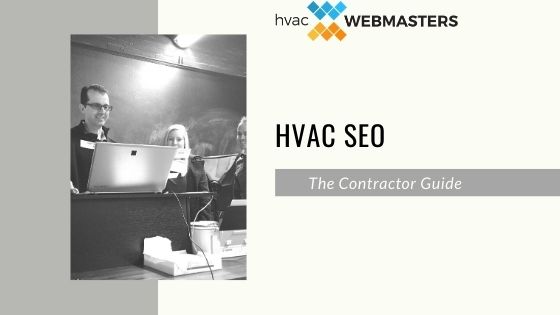
What is HVAC SEO?
HVAC SEO, or Search Engine Optimization, is currently the best way to acquire local HVAC customers and build company awareness. Effective SEO ensures your business appears above your competition on platforms like Google, Bing, and Yahoo.
SEO applies to both Google Search and Google Maps, along with your company website and business listing, respectively. The following comprehensive guide outlines tips, tricks, and recommendations based on 10+ years of professional SEO services for HVAC companies.

Expert Analysis
As the most tenured HVAC SEO agency in the United States, we can confidently say that SEO remains the most effective marketing strategy for heating and cooling professionals in 2024.
How SEO Changed in 2024
Google’s AI Chatbot, Bard, changed SEO in 2024. Recent algorithm updates like the Helpful Content Update and Link Spam Update also altered the SEO landscape. HVAC companies must now put more effort into EEAT: experience, expertise, authority, and trustworthiness.
Google’s upcoming Search Generative Experience (SGE) will change the landscape of search for HVAC companies. While the algorithm will still value factors like content quality, link authority, and on-page optimization, the standards for legitimizing your website and its content will rise considerably.
Today, HVAC sites must be well-written, provide a good user experience, and offer unique information to rank on SERPs. It must also include schema markup, precise metadata, images, videos, and media that match the discussed topic.
While effective SEO isn’t difficult to achieve, it can take time, skill, and knowledge of correct and effective practices.
Why HVAC SEO is Important
When someone in your area needs a service or product, chances are, they go to Google. If a consumer searches for “A/C repair in Dallas, TX,” a list of sites that present relevant terms, content, and information will appear.
The more relevant and useful the content, the higher on the results page it will be. Rankings set the order of the search results listed on search platforms. Since most customers don’t scroll down far, it’s essential to appear at the top of this list to generate leads for your business.
Applying effective SEO tactics will help your site rank higher in search results and list pertinent information, such as the phone number, location, and services listed. Prominent search visibility could lead to more inquiries, appointments, and business awareness for your HVAC company.
Properly implemented SEO can mean the difference between a fruitful customer base and closing the doors for good in today’s digital landscape.
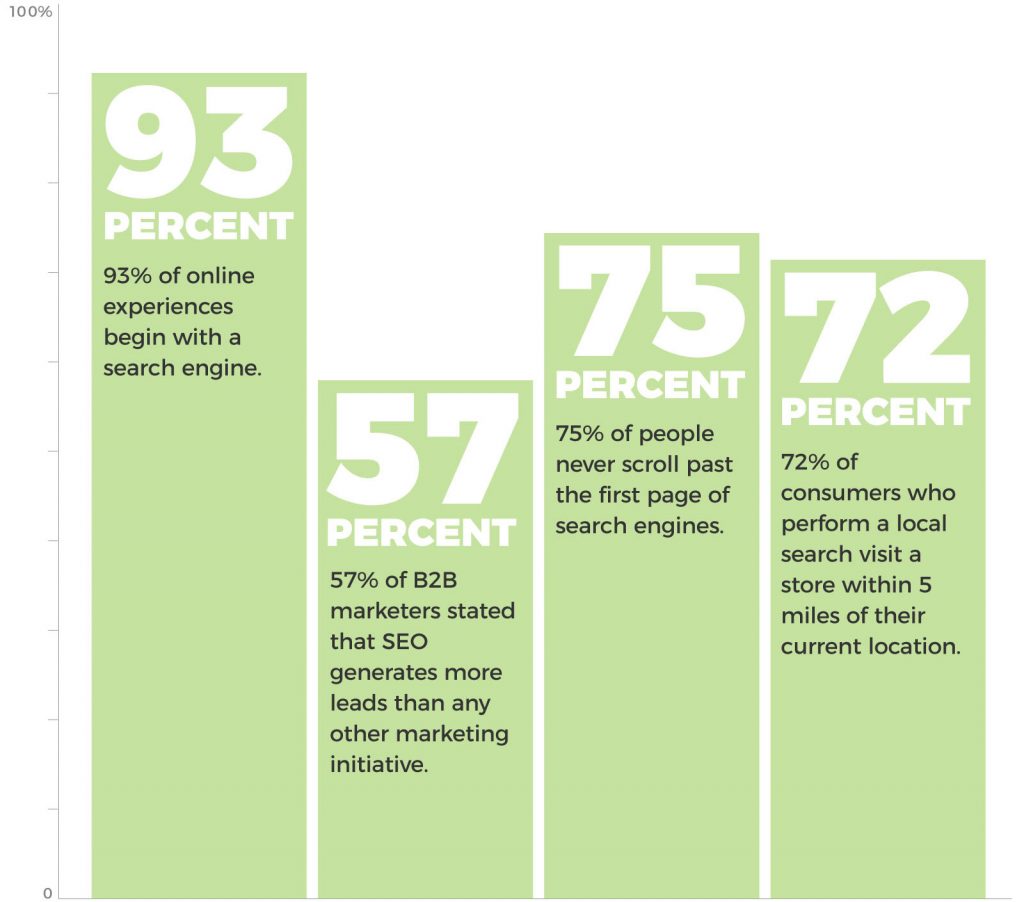
SEO Strategy: The Planning Stage
Your SEO strategy should not be done on the fly or without thought. Effective SEO is well-planned according to what consumers seek. Your SEO plan should include well-researched keywords, clear URL structures, and captivating images and videos, all of which lend to how well your site will rank with search engines.
Keyword planning is crucial for ranking well on search engine platforms and is the foundation of a good SEO plan. The goal of keyword selection is to identify words that will attract the most relevant searchers. Identify each word’s search volume, difficulty level, and competition level using programs such as MOZ, SEMRush, and Ubersuggest.
The search volume metric suggests how often users search the term during a search query. The difficulty level is a metric that identifies the level of difficulty of the word itself. The competition level demonstrates how often the word or phrase appears on other sites, developing a unique keyword set.
Evulate various metrics to identify the most viable keywords for your business. For instance, if a keyword applies to commercial HVAC repair and your company provides only residential repair, that keyword may not be the best option.
National Keywords
High-volume keywords like HVAC Repair, Air Conditioners, and Heaters are indexed according to the searchers’ location, so local businesses aren’t competing nationally for these terms. When creating your SEO plan, you should be aware of the top 100 national keywords in the HVAC field. This will help when creating URL hierarchy, content, and on-page SEO.
Identifying these top terms will also help when thinking of more specific longtail and service-related terms that pinpoint even more relevant searchers. Top keywords like these should be used throughout the site with a concentration on top-level pages to be indexed effectively and help SERP ranking.

Local Keywords
HVAC companies should use top keywords with a location reference for local optimization. For instance, if you’re an HVAC company in Wilmington, DE, a useful keyword may be heating in Dallas, TX, or Dallas, TX heating. Keyword research programs can help you discover which location tags are the most beneficial for your area.
For instance, “air conditioning in Dallas, TX” has a search volume of 210, while “Dallas Air Conditioning” has a search volume of 110. While using both keyword phrases in your content is good practice, the first option should focus on the best results.

Service Keywords
The most successful HVAC sites have subsequent pages describing their specific services in detail. These sites use more specific service keywords that focus on one category or service.
For example, if your HVAC company provides gas furnace repair and installation, then a realistic service keyword would be gas furnace services. Be sure to include location tags on these keywords as well for proper optimization.

URL Structure & Page Hierarchy
Once you have your list of keywords, you can begin to set up your URL structure and page hierarchy. Typically, sites have multiple pages that present information from a general to a more specific level. The organization of those pages is called the site or page structure.
Most HVAC websites have a top-level Home page, an About Us page, and a Location page. Besides, they may also have a few general service top-level pages such as “Heating” or “Air Conditioning.” From there, HVAC sites lead into secondary pages that may include categories like “Central A/C Service,” “Furnace Service,” or “Central Heating.”
The third level of pages branches out from that point, which addresses specific services like “Natural Gas Furnace Repair” and “Ductless A/C System Installation.” Your site structure helps Google index your pages for search rankings and be straightforward and easy to follow. The pages should flow nicely into each other and create a natural flow process for reaching them.

Along with your HVAC site’s page hierarchy, you should carefully consider the URL structure. It is critical to map out each URL, followed by Google and searchers. They should be short and concise and present the exact topic displayed along with a clear path to the information.
A well-planned HVAC URL may resemble something like https://yourhvaccompany.com/heating/furnace-repair. This URL has a clear path, includes top keywords, and presents a well-communicated subject.
Images & Videos
The most successful HVAC websites use images and videos representing the content and are clear and correctly sized. HVAC websites should choose photos and videos during the planning stage to ensure proper emphasis on the content and prevent duplicate usage.
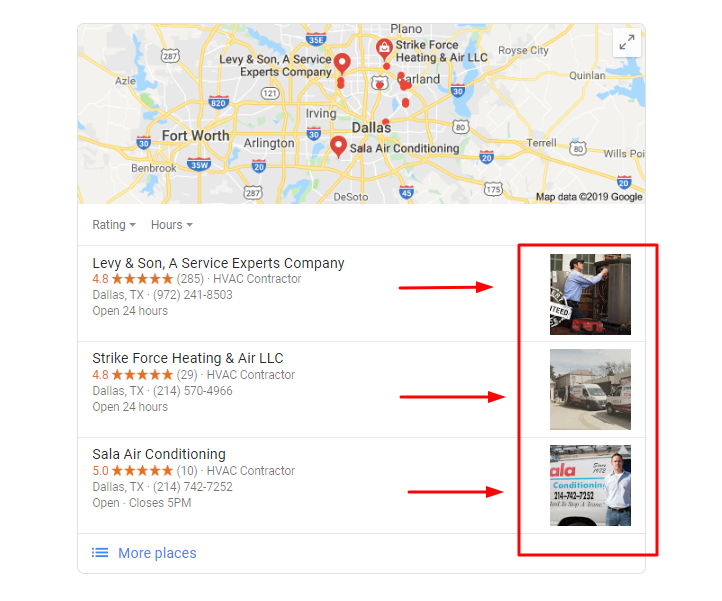
Google Business Profile Images should be unique and provide a look into your business, staff, and services.
Search Engine Optimization: The Implementation Stage
Once you have finished your SEO plan, you should have a clear layout of your site’s page structure along with keywords, images, videos, and URLs for each. However, more SEO tasks remain urgent. Your HVAC site’s design and usability also contribute to your SEO and should be constructed with the customer in mind.
Custom Design
While multiple usable templates are available for your HVAC site, a custom website design is always best regarding SEO and searchability. Templates lack the coding that Google uses to index information and keywords. A customized site design is needed to implement fundamental structure and coding details like schema, headers, and title tags.
Contact Information
A lack of easy-to-use contact information is one of the most significant contributors to high bounce rates and poor SEO ranking. Your HVAC site should have listed contact information on every site page, including a location address and map, phone number, and email address.
Your company’s phone number should also appear throughout the content for maximum usability. Not only does this lend to a boost in trust that can contribute to higher search rankings, but it also presents a better user experience that can help attract and retain visitors.
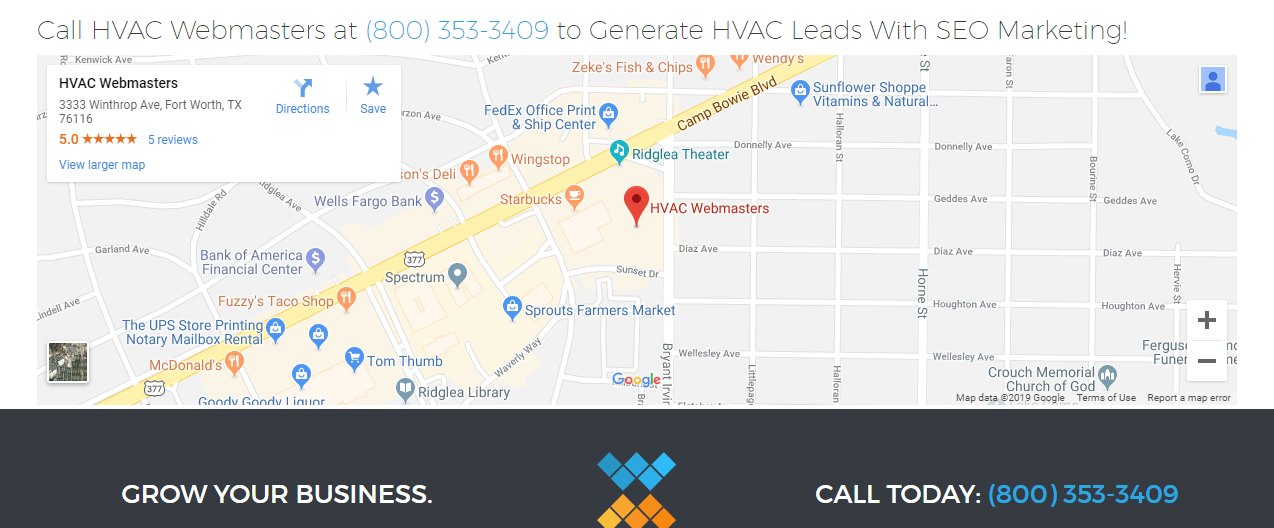
Call To Action
Any marketer worth his salt will tell you that a call to action is crucial. Your page’s call to action leads, instructs, and inspires your site’s visitor to complete the desired action, whether it be to schedule an appointment or call for more information.
For optimal SEO, every page on your HVAC site should have at least one call to action. It should be easy to find and conveniently located within your page to maximize usability and task completion.
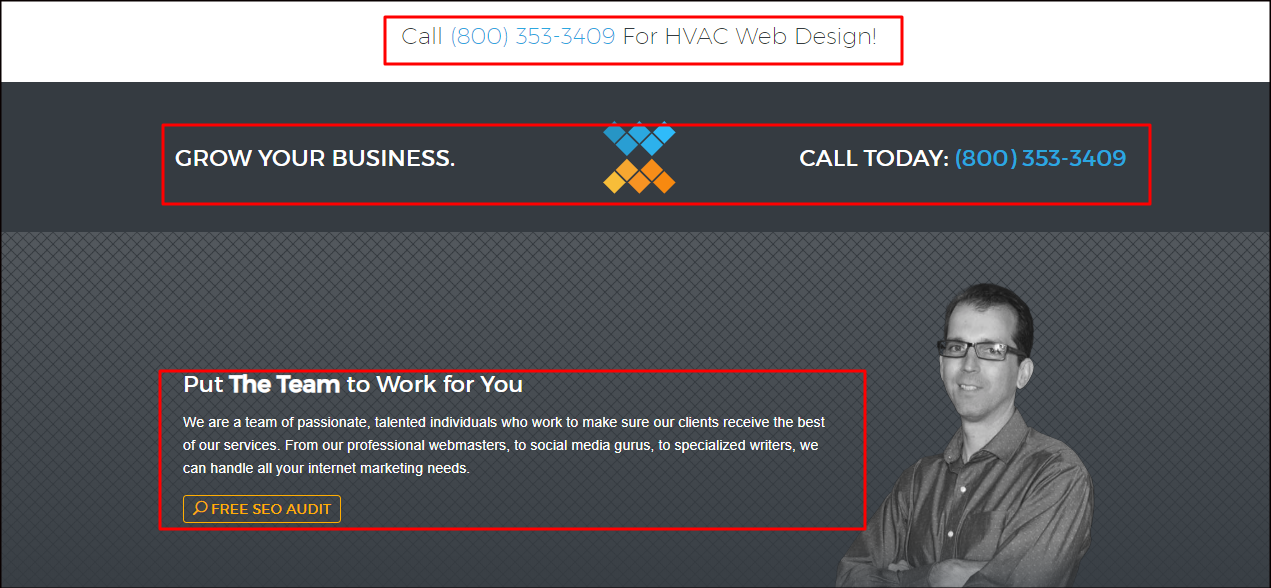
Website Personalization
Your company website is a reflection of the business itself. Your design should represent your HVAC company’s personality. If your HVAC business focuses on commercial service, you want a professionally presented site with a lot of structure and uniformity. However, if your company has a laid-back approach, you may want to use a broader color scheme or more vibrant design elements.
Badges, Accolades, and Testimonials
You work to get certifications and certificates that set you apart from your competition. Ensure that your site visitors know how skilled you are by displaying badges and accolades prominently with links back to the original site. Social proof communicates your abilities to prospective customers and provides outward-lining opportunities to reputable sites within your industry.

Testimonials also help promote your company by providing positive real-life experiences to your visitors and potential customers. You can display testimonials on your HVAC website and your Google Homepage to encourage searchers to choose your company.
Multimedia Content
The best way to hold user attention in today’s online landscape is with multimedia content, including videos, PDFs, or other interactive options. Along with providing backlink and sharing options that boost online trust and reputability, these additions create a better user experience, leading to lower bounce rates and higher conversion rates.
Multimedia content is also perfect for sharing on secondary platforms such as YouTube or social media, providing backlink and distribution opportunities. A company video, for example, can be added to YouTube and your site, then linked to Facebook, Instagram, and other platforms for maximum reach to potential clients.
Mobile Optimization
You must optimize your site for mobile use to rank on search engines. Mobile-optimized sites provide the viewer with the most critical information while hiding graphics, animations, and other secondary elements that could create longer load times.
Like mobile optimization, responsive design adjusts your content for the screen used to view it. Responsive sites manipulate information and graphics for the best view possible on smartphones, tablets, laptops, or desktops.
Local SEO for HVAC
The key to website success is local optimization. When your local HVAC SEO is in good shape, your business appears in “near me” and map searches, which are crucial for generating new business in today’s world. Local optimization is achieved through multiple tasks and techniques and can offer the boost you want to outdo your competition.

Local Business Citations
Citations are listings or mentions in other locations throughout the web that help build trust and recognition. When using Google to locate a service or product, we have all seen the search options that boast the “10 best professionals” in your field.
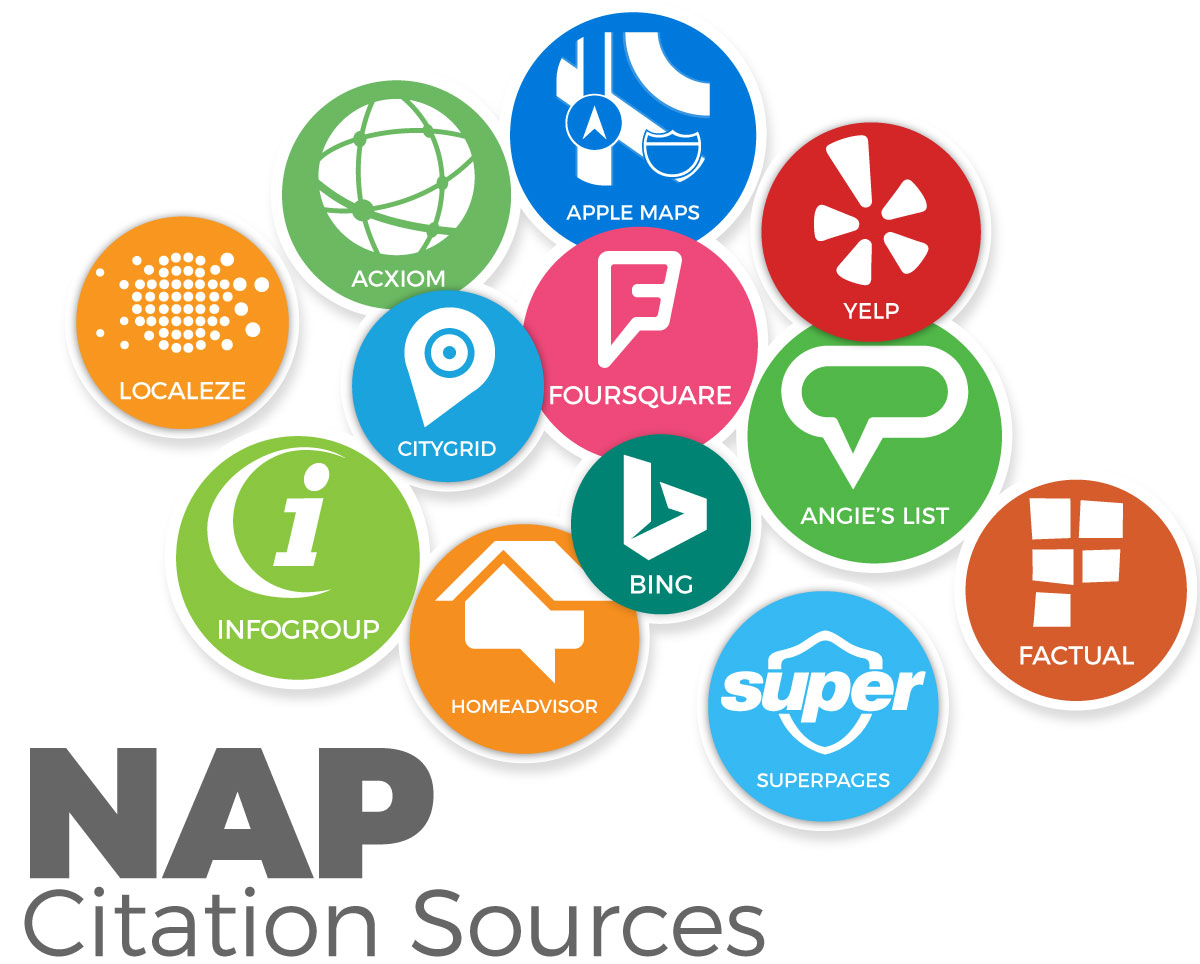
These are citation sites and can help boost your site’s ranking when appropriately used. Local directories such as Angie’s List, Yelp, and HomeAdvisor are all noteworthy directories that provide useful citations to boost your SEO.
NAP Consistency
One way to boost your local SEO efforts is by ensuring your NAP, or Name, Address, and Phone are consistent throughout the web. Your company name and contact information should be the same on each site where your business is listed.
NAP consistency helps Google and other search engines easily pair your location with your other business listings, which improves your credibility and online clout.
Google My Business Optimization
When searchers perform a branded search or a search of your company name, Google typically shows your knowledge graph. You find details like contact information, reviews, ratings, hours, and location within the knowledge graph.
You will also find links to company social media pages, directory listings, and other secondary business mentions.
Your Google Business Page is crucial for top rankings. The information entered into your Business Page will allow Google to index your company according to services, location correctly, and other details to ensure productive searchability.
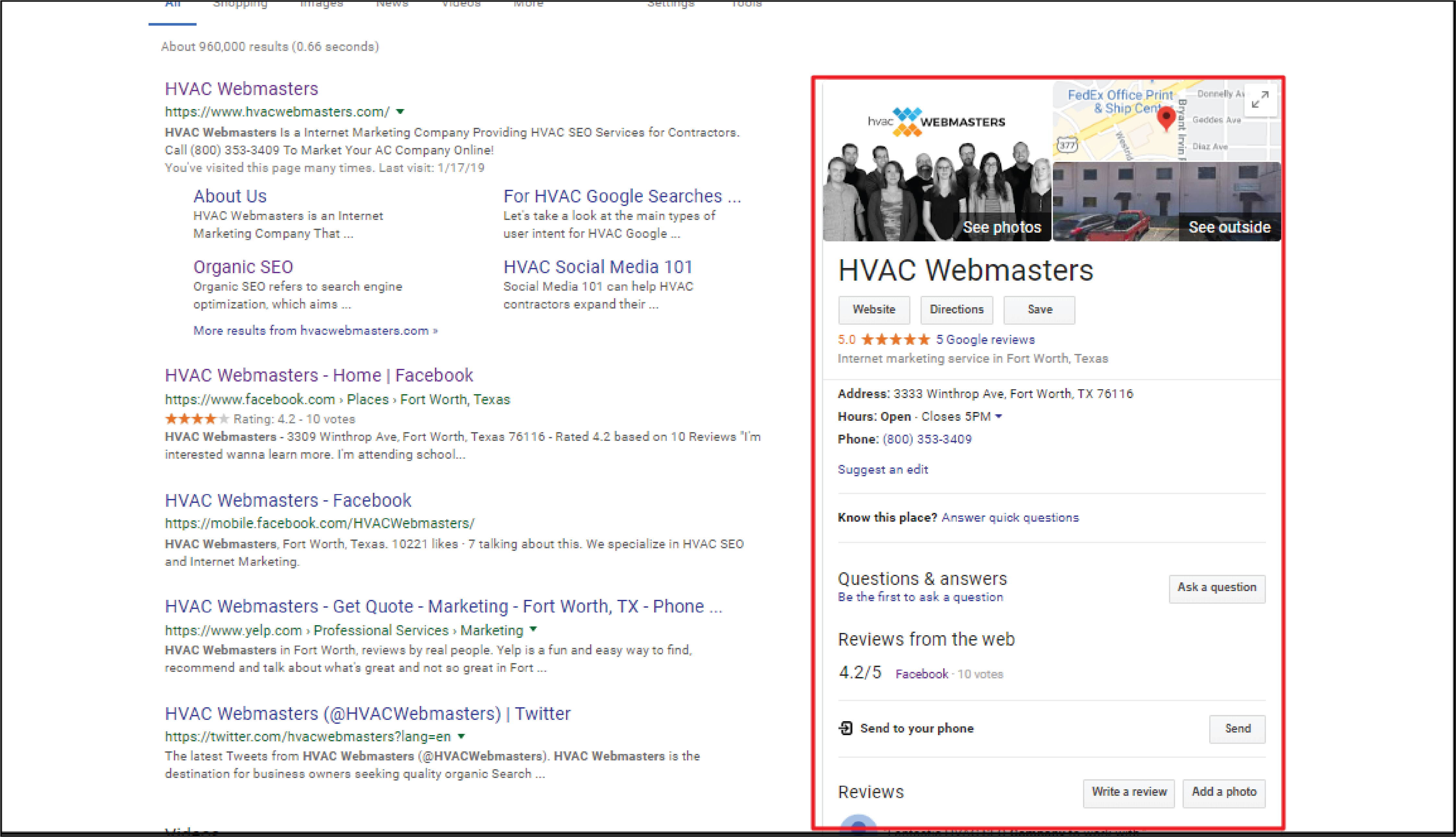
City Pages
In the past, a static list of your service area was enough to let searchers know where you provide services. Today, however, optimal SEO is achieved by adding city pages focused on each city that your company serves.
These pages are optimized for the services and location and are typically brought together by a linked list on a top-level ‘Areas Served’ page. Correctly optimized city pages allow Google to index every area your HVAC company serves readily.
Your HVAC site should ideally include a city page for every large city your business services. They should have unique content, images, and SEO elements and provide a clear overview of your company’s offerings.
Title tags should be used within the content and include a top keyword and a location tag to give optimal indexing to the specified area. This way, when users perform a location-based search, such as “heater repair in Palmdale, CA,” your Palmdale city page is displayed in the search results.
On-Page SEO for HVAC Companies
When a searcher enters a query, they are not usually taken to a website’s homepage but instead to a page within the site that presents the searched information. But how do search engines know which pages have the right content?
On-page SEO provides Google with clues about each page’s data, displayed through images, bullet points, headers, and other styling and formatting techniques. Google uses these details to determine what type of content is available on your site and where you’ll rank on SERPs.
Keyword Placement
Within your content, your keywords should be strategically placed and naturally flowing. They should be present in the general content, headers, image captions, and lists for optimal referencing during search queries.
Remember, the more relevant and more frequent your keywords are, the more likely Google is to display your content when users include the word in a search.
While using main keywords such as HVAC repair and HVAC installation is essential, you should also use more specialized secondary keywords in your content. These keywords provide more description and are more likely to provide high search rankings when users perform specific service or product searches.
Title Tags
Title tags are crucial for proper on-page SEO and provide Google with an overall description of your page. Tags are found in search results as the query title and at the top of the page when clicked.
Keep in mind that your title tags should be short and concise, having a max of 60 characters to display as they should. It should be descriptive and include the primary keyword and a location or brand tag.

Meta Descriptions
When users perform a Google search, the displayed results include a short snippet of information that paraphrases the content. The snippet is called the meta description, and Google uses it to index your content topic correctly.
When creating your meta description, you want to include a primary and secondary keyword, if possible, and contact and brand information. The full spectrum will help Google connect your content with your site, helping boost your rankings.
However, make sure to keep your meta description under 160 characters to prevent being cut off.

Header Tags
Header tags are used in content to separate different thoughts. Multiple header styles and sizes can be used when laying out your content and provide title breaks and content dimensions. When arranging your content, using header tags can help Google correctly index each paragraph’s topic on your page.
Strategically place header tags within the content to emphasize independent ideas and new thoughts. They should have between 20 and 70 characters for optimal viewing and indexing.
Your HVAC web page should combine H2 and H3 header tags to distinguish between main ideas and supporting thoughts. Headings help Google and other search engines accurately index your content and focus on search rankings.
URL Slugs
Your URL is your exact web address. Because Google uses your page URL to index your site and as a displayed object on SERPs, it’s vital to create it correctly. A useful URL will state the content clearly and use a top keyword related to the topic.
Many sites have not optimized their URL slugs and end up with slugs that make no sense or are hard to understand. An air conditioning repair page might have a URL slug of /air-conditioning-repair for a useful URL slug.
Google uses bots to crawl every site when users perform a search query. These bots use URLs to correctly and quickly index your HVAC site’s content.

Image Alt Text
Images can significantly improve your SEO efforts, but only if used correctly. While captions and image titles are important, Image Alt text is crucial for Google to index your image content correctly.
As search bots crawl your site, they index image subjects and content. When your image has appropriate tags and descriptions, Google can quickly tell what it’s about, leading to possible better rankings.
Other SERP Ranking Factors
Google and other search engines use various information and details to provide helpful search results for their users. While on-page and site-wide SEO is crucial, other factors also affect your business’ ranking. A collection of elements influence SERP position instead of a singular tipping point.
Domain Age
Your site and domain age are also factors that Google considers when presenting search results. A site that is ten years old is more established than a site that is six months old and will hold more clout on SERPs.
It’s essential to keep your domain once you have one. A well-established domain displays a reputable web address and not a “fly-by-night” site that helps with ranking.
Reviews
Reviews are also a deciding factor with SERPs. As your clients leave reviews of your company on different platforms, Google indexes them as reputability. Reviews also display on your Google knowledge graph, showing prospective clients what level of quality they can expect from your company.
The knowledge graph displays many more review types than Google alone, so it’s vital to encourage your clients to complete reviews on multiple platforms such as Facebook, Angi’, and HomeAdvisor for comprehensive coverage for your HVAC business.
Location
Your business location is a crucial deciding factor in your SEO development. New or less well-known sites will have trouble competing with larger companies and sites for top keywords in large cities and metro areas. In this case, utilizing secondary keywords can give your site the boost it needs.
Analyzing SEO Success
As with any business plan, your HVAC SEO campaign should be tracked through analytics to ensure its effectiveness. Luckily, Google and many other programs offer helpful tools for measuring your SEO success.
Google delivers first-class analytics that is easy to read and transfer so you can create useful and productive progress reports.
Google Analytics
With your Google My Business account, you can access Google Analytics to help track your site’s performance on Google. These metrics clearly show how your site is doing and what can be improved.
Each metric delivers valuable information on keywords, customer conversions, and even image reactions.
Along with Google Analytics, platforms like SEMRush, Moz, and CoreMetrics provide helpful metrics and analytics that judge your marketing plan’s effectiveness. No matter what platform you use to measure your SEO plan’s success, it’s essential to keep track of benchmarks, shortcomings, and other details to make effective adjustments.
Each component of effective SEO plays a part in the indexing and tracking of your site by Google and other search engines and will decide where, if at all, your site shows on search results. Therefore, an efficient plan, implementation schedule, and analytics method are crucial for business success in the online world.
Next Level HVAC SEO Tips for 2024
Google’s recent algorithm updates, including the Helpful Content Update, have increased the power of E-E-A-T or expertise, experience, authoritativeness, and trustworthiness. Heating and cooling websites that best demonstrate these qualities through branded signals will rank.
SEO remains the most affordable method to generate HVAC leads online. However, some of the tactics that previously led to consistent rankings on search engines are no longer viable. As a result, HVAC companies must adapt in order to maintain or increase Google visibility.
Tip 1: Digital + Branded Signaling
An HVAC company website should not aim to trick search engines but rather aim to establish a brand that search engines can trust enough to present to its users. The most effective way to achieve this is through E-E-A-T, which can be automated through the use of DataPins.
Another way to foster branded signaling is by creating content for users rather than search engines. As a result, those hundreds of thin blog posts your marketing company published on your HVAC website are counterproductive to search engine optimization in 2024.
Tip 2: Cross-Platform Brand Synergy
While a robust website is the most integral part of an HVAC SEO strategy, it’s not enough to establish a viable brand for your services. It’s important for your other digital entities, like your Google Business Profile (aka GMB listing) and social profiles, to link back to your website.
Think about Google Maps and YouTube, for example, as both platforms are now integrated within Google search results. Ensuring your HVAC company can rank on Google’s Local Map 3-Pack, video carousel, and traditional organic results is the epitome of SEO synergy in 2024.
Tip 3: Focus on User Intent
Content’s value is based on the accuracy with which it satisfies the user’s search intent. For example, if a local HVAC prospect searches for gas furnace repair services, the content that clearly outlines its gas furnace services and expertise is the most valuable to the searcher.
Google’s priority is its users (those searching for HVAC services). As a result, you must view your website as Google’s partner and something that can help satisfy their users’ search experience. When you view SEO through this lens, the required tasks become clear.
Next Steps for HVAC Companies
The emergence of AI tools like ChatGPT has sparked spirited conversations about the future of SEO for lead generation. As a top-rated marketing agency for HVAC companies throughout the U.S., our internal data shows that SEO is here to stay in 2024.
As the owner of a heating and cooling business, investing in SEO starts with a simple call to an agency like HVAC Webmasters. If you prefer to do SEO yourself for now, the first step is claiming and optimizing your Google Business Profile so you can appear on Google Maps.



